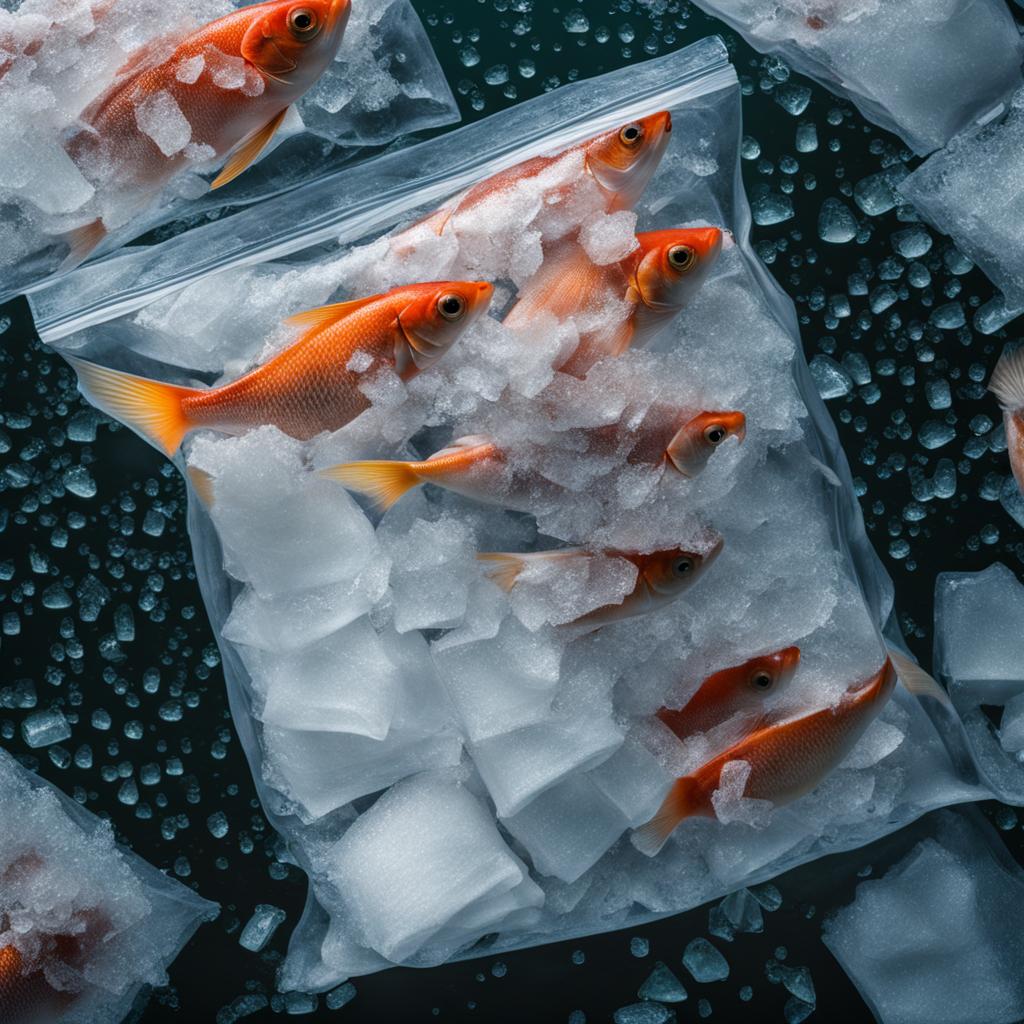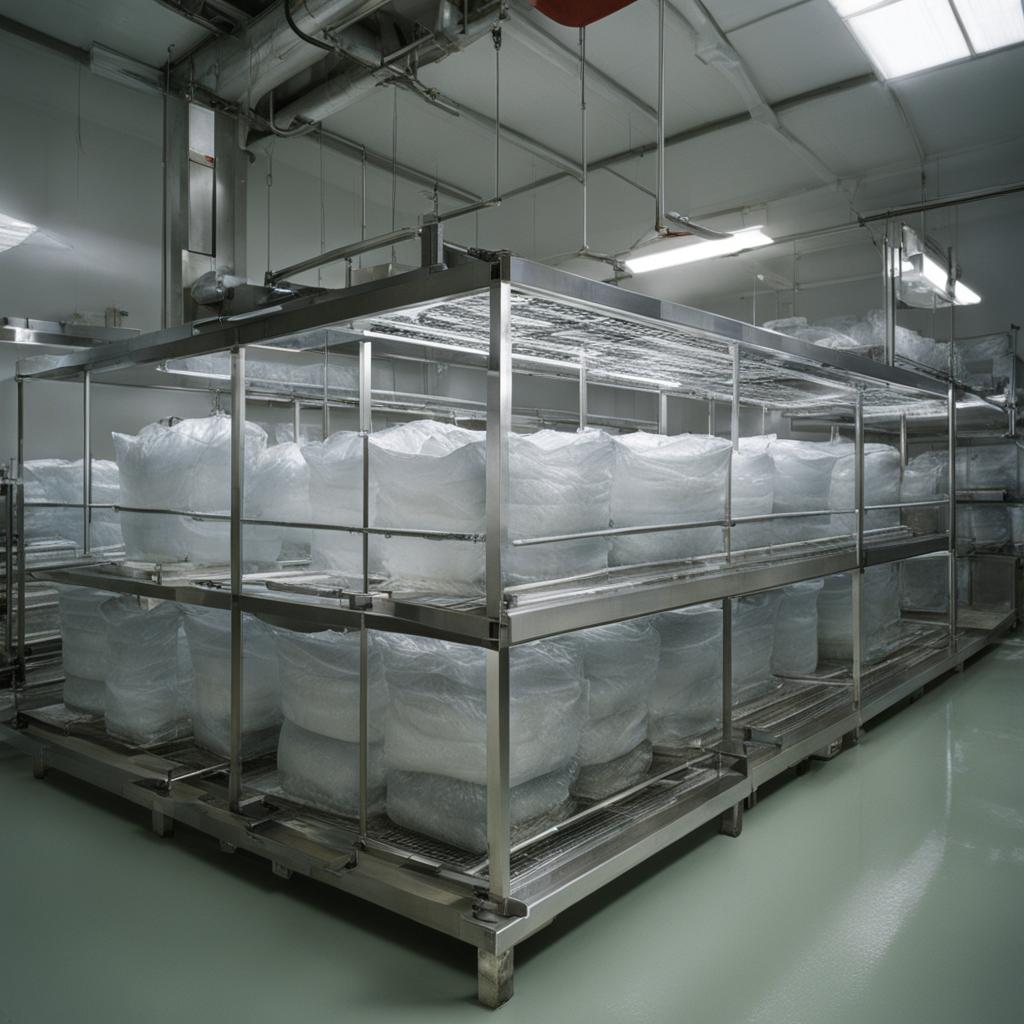Proper fish storage is essential for maintaining its freshness and taste. Whether you’ve caught your own fish or purchased it from a market, the way you store it can make a significant difference in its quality. In this article, I will guide you through the best methods and techniques to store fish and preserve its freshness for longer periods.
Key Takeaways:
- Storing fish correctly helps preserve its flavor and texture.
- Improper storage can lead to bacterial growth and spoilage.
- Fish should be stored at temperatures below 40°F (4°C) to slow down bacterial growth.
- Keeping fish dry and covered helps prevent moisture buildup and prolongs freshness.
- Placing fish on top of ice lowers the storage temperature and helps preserve its freshness for 2 to 3 days.
Why Proper Fish Storage is Important
Proper fish storage is crucial for preserving the flavor, texture, and overall quality of your seafood. By understanding the importance of fish preservation, handling, and storing techniques, you can ensure that your fish remains fresh and safe to consume.
Improper storage of fish can lead to bacterial growth and spoilage, resulting in unpleasant odors and potential health risks. The freshness of the fish can be compromised if it is not handled and stored correctly. Therefore, it is essential to utilize proper fish handling techniques to prevent deterioration and maintain its quality.
One of the key reasons why proper fish storage is important is to slow down bacterial growth. Fish should be stored at temperatures below 40°F (4°C) to inhibit the growth of bacteria that can cause spoilage. Lower temperatures, around 32°F (0°C), can help keep fish fresh for longer periods.
Proper fish handling and storing techniques are crucial to prevent bacterial growth, maintain the freshness of fish, and ensure the safety of your seafood.
Moisture is another factor that can accelerate bacterial growth and spoilage. It is important to keep fish dry during storage to prevent bacterial contamination. Storing fish fillets in a single layer and covering them well helps prevent moisture buildup and prolongs freshness.
By implementing these proper fish storage practices and techniques, you can enjoy fresh and high-quality seafood for longer periods, enhancing your culinary experiences and ensuring the safety of your meals.
The Importance of Proper Fish Storage
Proper fish storage plays a crucial role in preserving the freshness, taste, and safety of your seafood. Here are some key reasons why proper fish storage is important:
- Preventing bacterial growth: Proper handling and storing techniques help slow down bacterial growth, reducing the risk of spoilage and foodborne illnesses.
- Maintaining quality: By storing fish at the right temperature and keeping it dry, you can maintain its texture, flavor, and overall quality.
- Ensuring food safety: Proper fish storage practices help minimize the risk of contamination and ensure the safety of your meals.
- Minimizing waste: By storing fish properly, you can reduce the chances of spoilage and avoid unnecessary food waste.
Remember to follow the guidelines for fish storage to maximize freshness and optimize the taste of your seafood dishes. With proper fish preservation techniques, you can enjoy delicious and safe fish for longer periods.
Fish Storage Do’s and Don’ts
When it comes to fish storage, there are certain do’s and don’ts that you should keep in mind to ensure optimal freshness and quality:
- Do rinse fish fillets before storage to remove any surface bacteria or impurities.
- Do dry fish thoroughly before storing to prevent moisture buildup.
- Do store fish at temperatures below 40°F (4°C) to slow down bacterial growth.
- Don’t store fish at room temperature, as it promotes bacterial growth and spoilage.
- Don’t store fish in plastic bags without proper airflow, as it can lead to moisture buildup and fish spoilage.
- Don’t thaw frozen fish at room temperature, as it can result in uneven thawing and compromise the quality.
By following these do’s and don’ts, you can ensure the best storage conditions for your fish and enjoy fresh and delicious seafood every time.
Table: Recommended Fish Storage Temperatures
| Fish Type | Recommended Storage Temperature |
|---|---|
| Salmon | 32°F (0°C) |
| Tuna | 32°F (0°C) |
| Halibut | 32°F (0°C) |
| Mahi-Mahi | 32°F (0°C) |
| Snapper | 32°F (0°C) |
Table: Recommended fish storage temperatures for different types of fish.
Ideal Storage Temperature for Fish
Properly storing fish is crucial to maintain its freshness and extend its shelf life. One important factor to consider is the storage temperature. Fish should be stored at temperatures below 40°F (4°C) to slow down bacterial growth and prevent spoilage. Lower temperatures, around 32°F (0°C), can help keep fish even fresher for longer periods.
By storing fish at low temperatures, you create an environment that inhibits the growth of bacteria, which can cause fish to spoil quickly. It’s essential to keep fish cold to preserve its quality and taste. Refrigerating fish at temperatures between 32°F and 40°F ensures that it stays fresh and minimizes the risk of bacterial contamination.
When storing fish, it’s important to monitor the storage conditions regularly. Check the refrigerator or storage unit’s temperature using a thermometer to ensure it remains within the recommended range. Maintaining the ideal storage temperature for fish is key to keeping it fresh and safe to consume.
Tips for Maintaining Ideal Storage Temperature for Fish:
- Set your refrigerator’s temperature between 32°F and 40°F to create an optimal environment for fish storage.
- Regularly monitor the temperature using a thermometer to ensure it remains within the recommended range.
- Avoid overfilling the refrigerator, as it can hinder proper air circulation and affect the overall temperature consistency.
- Keep the refrigerator door closed as much as possible to prevent temperature fluctuations.
By following these guidelines, you can ensure that fish stays fresh and maintains its quality during storage. Proper storage temperature is just one aspect of fish preservation, but an essential one to keep in mind to enjoy delicious seafood for longer periods.
Keeping Fish Dry and Covered
When it comes to storing fish, keeping it dry and covered is essential for maintaining its freshness and quality. Moisture can promote bacterial growth and cause the fish to spoil more quickly. To prevent this, follow these fish storage guidelines and practices to ensure optimal preservation.
Single Layer Storage
One of the key practices for fish storage is to store fillets in a single layer. This helps prevent moisture buildup and allows for better air circulation around the fish, keeping it fresher for longer. Arrange the fillets on a tray or in a container, making sure they are not stacked on top of each other.
Proper Covering
After placing the fish fillets in a single layer, it’s important to cover them well. This helps create a barrier that prevents moisture from getting in and maintains the fish’s freshness. You can use plastic wrap or aluminum foil to cover the tray or container tightly, ensuring a secure seal.
Benefits of Dry and Covered Storage
Keeping fish dry and covered offers several benefits for maintaining its quality. Firstly, it helps prevent the growth of bacteria, which can lead to spoilage and unpleasant odors. Secondly, it helps retain the natural moisture in the fish, keeping it moist and tender. Lastly, it helps protect the fish from any contaminants or odors in the refrigerator, ensuring that its flavor remains intact.
By following these fish storage practices and guidelines, you can prolong the freshness and quality of your fish, ensuring that it’s at its best when you’re ready to cook and enjoy it.
Using Ice for Fish Storage
When it comes to preserving the freshness of fish, ice is a valuable ally. The strategic use of ice can extend the storage duration of fish, ensuring it remains in optimal condition for longer periods. By lowering the storage temperature, ice helps slow down bacterial growth and delays spoilage, keeping your fish fresh and safe to consume.
To use ice effectively for fish storage, it’s important to have the right containers or bags. Insulated coolers or ice chests are excellent options for larger quantities of fish, as they provide insulation and help maintain a consistent temperature. Additionally, using reusable, leak-proof containers or bags designed specifically for freezer storage can ensure the ice doesn’t melt too quickly and compromise the fish’s quality.
To store your fish using ice, place it on top of a layer of ice in the chosen container or bag. Make sure the fish is well-wrapped and sealed to prevent moisture from seeping in and compromising the flesh. The ice acts as a cooling agent, keeping the fish at an ideal temperature for freshness. Remember to replenish the ice as needed to maintain the desired storage conditions.
| Benefits of Using Ice for Fish Storage | Tips for Using Ice |
|---|---|
|
|
By following these guidelines and using ice effectively, you can extend the storage duration of your fish, allowing you to enjoy it at your convenience without compromising its quality. Proper fish storage containers and the use of ice are essential tools for any seafood lover who wants to savor the best flavors, even when they’re not immediately available.

Alternative Storage Method
If you’re looking for alternative ways to store fish, specialized trays, racks, or bins can be a great option. These containers are designed to help separate the fish and maintain optimal storage conditions, ensuring your seafood stays fresh for longer periods.
Using fish storage trays allows you to organize and stack your fish fillets or whole fish, making it easier to access and monitor your stock. These trays often come with built-in drainage systems, preventing moisture buildup and ensuring your fish stays dry. Additionally, fish storage racks provide a convenient solution for storing multiple fish at once, with adjustable compartments to accommodate different sizes and varieties.
If you prefer a more compact storage option, fish storage bins are a practical choice. These bins are specifically designed to keep fish fresh by providing a sealed and controlled environment. They often feature airtight lids and adjustable dividers, allowing you to customize the space according to your needs. Fish storage bins are commonly used in professional kitchens, where freshness and organization are paramount.
| Benefits of Alternative Fish Storage Containers | Trays | Racks | Bins |
|---|---|---|---|
| Ease of Access | |||
| Organizational Efficiency |  |
||
| Moisture Control |
When using alternative fish storage containers, it’s important to clean them thoroughly before and after each use. Proper hygiene practices will help maintain the quality and freshness of your fish. Whether you choose trays, racks, or bins, incorporating these specialized storage solutions into your kitchen can enhance your overall fish storage experience.
Reducing Plastic Waste in Fish Storage
To minimize plastic waste, consider using aluminum sheet pans as an alternative to plastic bags. Nestle the fish on the pan, place it on a layer of ice, and cover it with another pan. This method requires fewer plastic materials and still keeps the fish fresh.
By using aluminum sheet pans, we can reduce our reliance on plastic bags and contribute to a more sustainable approach to fish storage. Not only does this method help to reduce plastic waste, but it also offers practical benefits for keeping fish fresh.
Aluminum sheet pans provide a sturdy and durable option for storing fish. They are resistant to tearing or puncturing, ensuring that the fish remains well-protected. Additionally, the use of a layer of ice helps to maintain a low temperature, preserving the fish’s freshness for longer periods. The covering pan offers an extra layer of protection, preventing any cross-contamination or odors from affecting the fish.
Overall, the use of aluminum sheet pans as an alternative to plastic bags in fish storage is a simple yet effective way to reduce plastic waste. It provides a practical solution that not only benefits the environment but also helps to maintain the quality and freshness of the fish. By making this small change in our fish storage practices, we can contribute to a more sustainable future while still enjoying delicious seafood.

Best Practices for Storing Fish
When it comes to storing fish, it’s important to have the right equipment, tools, and appliances to ensure optimal freshness. Proper storage techniques will help maintain the flavor and quality of your seafood. Here are some best practices to follow:
- Zip-top bags or aluminum sheet trays: Rinse fish fillets, dry them thoroughly, and place them in zip-top bags or aluminum sheet trays. These containers provide airtight protection and prevent moisture buildup, helping to extend the shelf life of the fish.
- Vacuum sealing machines: For a professional touch, consider using vacuum sealing machines. These devices remove air from the packaging, creating a vacuum seal that significantly prolongs the freshness of the fish. Vacuum-sealed fish can be stored in the freezer for an extended period without sacrificing flavor or texture.
- Ice: It’s crucial to keep fish cold during storage to prevent bacterial growth. Place the fish on a tray or plate lined with ice, ensuring that it stays chilled. This method is particularly effective for short-term storage in the refrigerator.
By employing these practices, you can maximize the freshness and quality of your stored fish. With the right equipment and tools, you’ll be able to enjoy delicious seafood whenever you desire.
Table: Fish Storage Equipment
| Equipment | Description |
|---|---|
| Zip-top bags | Airtight bags that help prevent moisture buildup |
| Aluminum sheet trays | Containers that provide a flat surface for fish storage |
| Vacuum sealing machines | Devices that remove air from packaging for extended freshness |
| Ice | Used to keep fish cold during storage |
Guidelines for Storing Whole Fish
When it comes to storing whole fish, there are a few important precautions to follow. Proper handling and storage techniques will help maintain the quality and freshness of the fish. Here are some guidelines to ensure optimal storage:
- 1. Rinse and dry: Firstly, rinse the whole fish under cold water to remove any impurities. Pat it dry with a paper towel to prevent excess moisture, which can lead to bacterial growth.
- 2. Wrap in protective covering: Use waxed paper, plastic wrap, or aluminum foil to tightly wrap the whole fish. This will help to prevent moisture loss and protect it from contaminants in the refrigerator.
- 3. Choose the right storage location: Place the wrapped fish on a tray or plate, ideally in a single layer. This will provide stability and prevent the fish from touching other foods, reducing the risk of cross-contamination.
- 4. Keep it cold: Store the wrapped fish on ice or in the refrigerator at a temperature below 40°F (4°C). This ensures that the fish stays fresh and slows down bacterial growth.
- 5. Avoid overcrowding: If storing multiple whole fish, make sure to leave enough space between them to allow air circulation. This helps maintain the proper storage temperature and prevents the fish from spoiling.
By following these precautions, you can ensure that your whole fish remains fresh and safe for consumption. It’s essential to maintain proper storage conditions and prevent cross-contamination to preserve the flavor and quality of the fish.
| Storage Precautions for Whole Fish | Storage Compartments | Storage Systems |
|---|---|---|
| Rinse and dry the fish before storage | Use separate compartments to prevent cross-contamination | Utilize specialized storage systems for whole fish |
| Wrap the fish tightly in protective covering | Ensure proper air circulation to maintain freshness | Store the wrapped fish on ice or in the refrigerator |
| Choose an appropriate storage location | Leave space between fish to prevent overcrowding | Maintain a temperature below 40°F (4°C) |
Implementing these guidelines and using suitable storage compartments or systems can enhance the preservation of whole fish and prolong its freshness. Following these precautions not only ensures the safety and quality of the fish but also allows you to fully enjoy its delicious flavors in your meals.
Keeping Fish Lively Before Storage
When it comes to storing fish, it’s important to ensure that the fish remains in the best possible condition before it goes into storage. Proper fish storage hygiene and instructions are crucial to maintain freshness and quality. Here are some tips to keep your fish lively before storage:
- Handle the fish with care: Treat the fish gently to minimize stress and prevent injury. Avoid dropping or mishandling the fish, as this can lead to bruising and damage to the flesh.
- Keep the fish in a suitable environment: If you have live fish, it’s essential to maintain a healthy and suitable environment. Ensure the water temperature is appropriate for the species and that there is enough oxygen in the water to keep the fish alive and healthy.
- Chill the fish: If you’re not able to keep the fish alive until storage, chilling it is the next best option. Place the fish in a container filled with ice or ice packs to keep it cold. This will help slow down bacterial growth and maintain the quality of the fish.
“Proper handling and maintaining a healthy environment for live fish is crucial to ensure freshness and quality.”
By following these simple instructions, you can ensure that your fish remains lively and in optimal condition before it goes into storage. This will ultimately result in a better-tasting end product when it comes time to cook and enjoy your seafood.
Expert Tip: Avoid Overcrowding
One important consideration when keeping fish lively before storage is to avoid overcrowding them. Overcrowding can lead to increased stress and the spread of diseases among the fish. Ensure that each fish has enough space to swim freely and that the water quality is maintained at an optimal level. This will help promote a healthy and lively fish before it enters storage.
| Fish Storage Hygiene Tips | Instructions |
|---|---|
| Handle the fish gently | Treat the fish with care to prevent injury and damage. |
| Maintain a suitable environment | Ensure the water temperature and oxygen levels are appropriate for the fish. |
| Chill the fish | Place the fish on ice or ice packs to keep it cold and slow down bacterial growth. |
| Avoid overcrowding | Provide enough space for each fish to swim freely and maintain water quality. |
Tips for Freezing Fish for Long-Term Storage
When it comes to preserving fish for extended periods, freezing is a reliable method that ensures freshness and flavor. Follow these simple tips to freeze fish effectively and maintain its quality over time.

Choose Fresh Fish
Start with fresh fish to ensure the best results when freezing. Look for fish that has been properly handled and stored at the fish market or grocery store. Freshness is key to maintaining flavor and texture, even after freezing.
Proper Cleaning and Packaging
Thoroughly clean the fish, removing all scales and entrails. Rinse it under cold water and pat dry with paper towels. Then, wrap each fish fillet tightly in aluminum foil or freezer-grade plastic wrap, ensuring there are no air pockets. This step prevents freezer burn and preserves the fish’s natural juices.
Label and Date
Don’t forget to label each package with the type of fish and the date of freezing. This information will help you keep track of the storage time and make it easier to identify specific fish varieties in the future.
Optimal Freezing Conditions
Place the wrapped fish fillets in airtight freezer bags or containers to provide an extra layer of protection. Make sure to remove as much air as possible to prevent ice crystals from forming. Store the fish in the coldest part of your freezer, maintaining a temperature of 0°F (-18°C) or below for optimal freshness.
Freezer Storage Duration
To maintain top quality, consume frozen fish within three to six months. While the fish will still be safe to eat beyond this timeframe, it may start to lose its texture and flavor. Keeping track of the freezing date will help you stay within the recommended storage time.
Thawing Frozen Fish
When you’re ready to use the frozen fish, thaw it properly to ensure even cooking. The best method is to thaw it slowly in the refrigerator overnight. Alternatively, you can place the wrapped fish in a sealed plastic bag and submerge it in cold water. Avoid using warm water or thawing at room temperature to prevent the growth of harmful bacteria.
Cooking Tips
Once the fish is thawed, it’s time to unleash your culinary creativity. Season it with your favorite herbs and spices, and cook it using your preferred method—whether that’s baking, grilling, pan-frying, or poaching. The key is to cook the fish thoroughly to a safe internal temperature of 145°F (63°C) to enjoy a delicious seafood meal.
By following these fish storage recommendations and freezing techniques, you can maintain the quality of your fish and enjoy it anytime, even during offseasons or when fresh fish is not readily available.
Fish Storage Hacks and Regulations
When it comes to storing frozen fish, having a few handy hacks up your sleeve can make the process more convenient and efficient. Let’s explore some practical tips to ensure optimal fish storage and discover the essential regulations to keep in mind.
Proper Thawing Techniques
Thawing frozen fish correctly is crucial for maintaining its texture and flavor. Avoid the temptation to thaw fish at room temperature, as this can lead to uneven thawing and compromise the quality. Instead, opt for two safe methods: refrigerator thawing and cold water thawing.
To thaw fish in the refrigerator, simply transfer it from the freezer to the fridge the night before you plan to cook it. This slow thawing process allows the fish to defrost evenly while maintaining its freshness. If you’re short on time, you can use the cold water method. Place the fish in a leak-proof plastic bag and submerge it in cold water. Remember to change the water every 30 minutes to ensure it stays cold. This method allows for quicker thawing, but it’s important to cook the fish immediately after thawing.
Cooking Delicious Frozen Fish
When cooking frozen fish, it’s important to employ specific techniques that bring out its best flavors. Adding extra seasonings and flavors can help enhance the taste of frozen fish. Consider marinating the fish for a few hours before cooking to infuse it with delicious flavors. You can also experiment with different cooking methods, such as baking, grilling, or pan-searing, to bring out the natural flavors and textures of the fish.
Following these fish storage hacks and regulations can help you maintain the quality and taste of your seafood, ensuring a delightful dining experience. Remember to thaw frozen fish safely and make use of various cooking techniques to unlock its full potential. With these tips in mind, you’ll be well on your way to enjoying delicious fish dishes year-round.
| Thawing Techniques | Advantages |
|---|---|
| Refrigerator Thawing | – Allows even and gradual thawing – Maintains fish freshness |
| Cold Water Thawing | – Quicker thawing method – Requires changing water every 30 minutes |
Thawing frozen fish correctly is crucial for maintaining its texture and flavor. Avoid the temptation to thaw fish at room temperature, as this can lead to uneven thawing and compromise the quality.
- Thaw fish in the refrigerator overnight for even thawing
- Use the cold water method for quicker thawing, ensuring to change the water every 30 minutes
- Experiment with different cooking techniques and seasonings to enhance the flavor of frozen fish
Conclusion
In conclusion, proper fish storage is crucial to maintain freshness and meet the necessary standards and requirements. By following the right practices and techniques, you can ensure that your seafood remains at its best quality when preparing delicious dishes.
Storing fish at the ideal temperature below 40°F (4°C) and keeping it dry and covered helps prevent bacterial growth and prolongs freshness. The use of ice or specialized containers also contributes to maintaining the desired storage conditions.
Reducing plastic waste in fish storage can be achieved by utilizing alternative solutions such as aluminum sheet pans. This approach requires fewer plastic materials while still effectively keeping fish fresh.
Remember to rinse and dry fish thoroughly before packaging, removing all air from the packaging to avoid freezer burn. Whether freezing fish for long-term storage or thawing and cooking frozen fish, following proper techniques ensures the best flavor and quality for your seafood dishes.
FAQ
How should I store fish to ensure freshness?
Proper fish storage involves keeping it at temperatures below 40°F (4°C), storing fish fillets in a single layer, and covering them well to prevent moisture buildup. Placing fish on top of ice or using specialized trays, racks, or bins can also help maintain freshness.
Why is proper fish storage important?
Proper fish storage is important to preserve flavor and texture, prevent bacterial growth and spoilage, and maintain the quality of the fish. By following the right fish handling and storing techniques, you can prevent deterioration and enjoy fresh seafood for longer periods.
What is the ideal storage temperature for fish?
Fish should be stored at temperatures below 40°F (4°C) to slow down bacterial growth. Lower temperatures, around 32°F (0°C), can help keep fish fresh for longer periods.
How can I keep fish dry and covered during storage?
Storing fish fillets in a single layer and covering them well helps prevent moisture buildup and prolongs freshness. This can be done by placing the fish on top of ice or using specialized trays, racks, or bins.
Can I use ice for fish storage?
Yes, placing fish on top of ice lowers the storage temperature and helps preserve its freshness for 2 to 3 days. Using ice packs or crushed ice in suitable containers or bags is an effective way to keep fish cold during storage.
Is there an alternative storage method for fish?
Yes, specialized trays, racks, or bins can be used to separate the fish and maintain proper storage conditions. These containers are commonly used in professional kitchens.
How can I reduce plastic waste in fish storage?
To minimize plastic waste, consider using aluminum sheet pans as an alternative to plastic bags. Nestle the fish on the pan, place it on a layer of ice, and cover it with another pan. This method requires fewer plastic materials and still keeps the fish fresh.
What are the best practices for storing fish?
Rinse the fish fillets, dry them thoroughly, and place them in zip-top bags or aluminum sheet trays. Remove all air from the packaging and set the fish on a tray or plate lined with ice. Store the setup on the bottom shelf of the fridge for optimal freshness.
How should I store whole fish?
Rinse the whole fish, dry it, and wrap it in waxed paper, plastic wrap, or aluminum foil. Place it on ice or in the refrigerator in a single layer. Use separate compartments or systems to avoid cross-contamination.
How should I keep live fish before storage?
If you have live fish, keep them alive or chilled with ice until you’re ready to store them. Proper handling and maintaining a healthy environment for live fish is crucial to ensure freshness and quality.
Can I freeze fish for long-term storage?
Yes, freezing is a common method to extend the shelf life of fish. Clean the fish, remove as much air as possible from the packaging, and wrap it in aluminum foil or freezer-grade cling wrap. Alternatively, use vacuum sealing machines for a professional touch.
How should I thaw and cook frozen fish?
Thaw frozen fish in the refrigerator overnight or in cold water, avoiding thawing at room temperature to prevent uneven thawing. Cooking frozen fish with additional seasonings and using proper cooking techniques helps enhance its flavor.
Why is proper fish storage important?
Proper fish storage is essential to maintain freshness, preserve flavor and texture, and ensure the best quality when preparing seafood dishes. By following the right practices and techniques, you can enjoy delicious and safe fish for longer periods.
Source Links
- https://www.seriouseats.com/best-way-to-store-fish-refrigerator-ice-packs
- https://www.takemefishing.org/how-to-fish/how-to-catch-fish/how-to-store-fish/
- https://www.in-fisherman.com/editorial/how-to-keep-fish-fresh/156660
Related Recipes:
 How to Store Chicken Safely
How to Store Chicken Safely
 How Long Can Yogurt Sit Out? Guidelines and Safety
How Long Can Yogurt Sit Out? Guidelines and Safety
 How Long Can Cooked Chicken Sit Out? Safety Tips.
How Long Can Cooked Chicken Sit Out? Safety Tips.
 How Long Can Pizza Sit Out? Safety and Storage Tips
How Long Can Pizza Sit Out? Safety and Storage Tips
 How to Store Baked Goods to Keep Them Fresh
How to Store Baked Goods to Keep Them Fresh
 How to Store Parsley? (Perfect Every Time!)
How to Store Parsley? (Perfect Every Time!)
 How to Store Carrots? (Perfect Every Time!)
How to Store Carrots? (Perfect Every Time!)
 Beef Stew Shelf Life: How Long Does It Last in the Fridge?
Beef Stew Shelf Life: How Long Does It Last in the Fridge?








